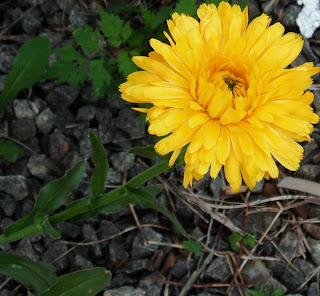
I am reminded this is suppose to be a gardening blog. Unfortunately, I have lost all motivation in the face of a second summer of unprecedented heat. Funny how 107 degrees will do melt any amount of resolve.
So today we have photos of lovely flowers which in fact
did exist at some point this spring in my garden - but I will not commit to saying they are still out there. Or, at least, they are not out there and alive.

The wire grass has taken over all the spots it did
not take over last year ( when I was busy killing it in the garden itself). I made the mistake of not covering the entire yard with black plastic and nuking it afterwards. So now the wire grass has consumed the blueberry and strawberry patch. Meanwhile the volunteer potatoes have come up, but haven't amounted to much besides some beautiful greenery.
This year even the gourd plants are lagging behind (and it's
never too hot or dry for gourds), leaving me with the possibility that there will be no Swan Neck gourds, no Nest Egg gourds, no Dipper gourds.
There are a few tomatoes and pepper plants out there -occasionally I wave at them from the upstairs window and remind them they are on their own -it's too hot to even deal with them. They seem depressed.

Wild hollyhocks have overtaken the rosebed, along with a particularily vicious thorned locust tree. On a more positive note, the fig tree is growing at breakneck speed, and I have no idea why, since I rescued it from the dead plant bin at Lowe's two years ago, planted it and then forgot exactly where I put it, much less to water it.

Meanwhile, I do have tomatoes, green peppers, jalapenos, sage, calendula, oregano, and a million different kinds of basil growing in containers up by the house, near the water barrels and a bit of shade.
It's just too freaking hot.
We did have these...
 Fine, so they aren't mine. Wire grass ate my strawberry plants. These came from my mom's, She's having her own garden issues this year. Peaches didn't set, corn isn't filling out, lettuce is bolting much too soon - see? It's not just me.
Fine, so they aren't mine. Wire grass ate my strawberry plants. These came from my mom's, She's having her own garden issues this year. Peaches didn't set, corn isn't filling out, lettuce is bolting much too soon - see? It's not just me.
Happily, blueberry season opened today, but I am forcing myself to wait until Thursday when it will be a cold frosty 87 degrees.
All I have to deal with there are the emus.

 The proverbial pistols at twilight....
The proverbial pistols at twilight.... It's my fault for planting so many tasty things and even providing bathing water in the bird bath. Still, I did warn them about nesting in the garage, and randomly buzzing me.
It's my fault for planting so many tasty things and even providing bathing water in the bird bath. Still, I did warn them about nesting in the garage, and randomly buzzing me.  Particularily the two baseball size nests out in the garage. Meaning the two nests that were attacked this evening with two full cans of 20-foot-spray, and then conclusively wiped out with three foggers, because dying wasps release a pheromone that alerts their buddies, and we can't risk a sneak attack tomorrow morning.
Particularily the two baseball size nests out in the garage. Meaning the two nests that were attacked this evening with two full cans of 20-foot-spray, and then conclusively wiped out with three foggers, because dying wasps release a pheromone that alerts their buddies, and we can't risk a sneak attack tomorrow morning.




















































